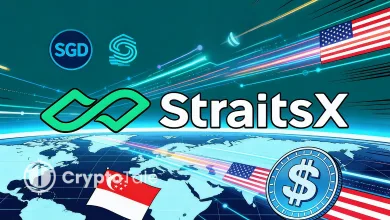Solv Protocol Launches BTC+ Vault to Unlock Bitcoin Yield

- BTC+ vault uses DeFi lending, staking, and real assets to help BTC holders earn passive income.
- Chainlink’s on-chain proof and dual-layer storage improve safety for long-term BTC users.
- BTC+ lets funds stay liquid and earn returns without needing to sell or move actual BTC.
Solv Protocol has launched BTC+, an automated yield vault designed to convert passive Bitcoin holdings into actively productive assets. The vault deploys a mix of strategies, including DeFi credit markets, basis arbitrage, tokenized real-world assets, and protocol staking. With over 17,480 BTC valued at more than $2 billion locked in Solv, the protocol targets over $1 trillion in dormant institutional Bitcoin.
BTC+ offers a base return of 4.5% to 5.5% and operates with a dual-layer structure for greater security and control. It separates custody from execution, enhancing protection for assets while facilitating complex yield-generating strategies. This separation is paired with Chainlink’s Proof-of-Reserves system, which allows real-time on-chain verification and reduces exposure to risk.
Backed by Binance Labs, OKX Ventures, and Blockchain Capital, Solv’s move aligns with broader institutional efforts to extract fixed-income-style returns from crypto assets. Competing platforms like Coinbase and XBTO have also launched Bitcoin yield products in response to rising demand from fund managers and large investors.
How BTC+ Vault Generates Yield
At its core, BTC+ turns Bitcoin into a capital-efficient asset by using advanced, automated strategies aimed at minimizing risk and maximizing yield.
BTC+ executes basis arbitrage, a method that profits from the price difference between spot and derivatives markets. It also uses protocol staking, which locks Bitcoin in staking platforms to earn on-chain rewards. These tactics are enhanced by real-world asset integration, where BTC is exposed to tokenized investment vehicles like BlackRock’s BUIDL fund, enabling a diversified and sustainable return stream.
Solv’s use of DeFi credit markets ensures access to lending and borrowing protocols, adding another layer of capital productivity. These strategies are actively managed but supported by transparent safeguards, including daily proof-of-reserves and drawdown protection tools based on net asset value (NAV).
SolvBTC Unlocks Yield for Institutional Bitcoin
Deposits currently settle on Ethereum, Arbitrum, and BNB Chain, with support for native Bitcoin inscriptions expected once BitVM bridges are live. This multi-chain setup hides network complexity while ensuring liquidity remains deep and accessible.
The consequence of this tokenization is that SolvBTC can be redeemed at a 1:1 ratio against the native BTC. It is also usable as a purse or it can be traded at different locations without generating taxable events, which is central to institutional users. This makes it possible to store or rotate SolvBTC flexibly by treasuries, in particular with the limited scope of the regulatory environment.
Solv explains that there is a very small percentage of the Bitcoin supply locked into DeFi, and most of the ETH is actively staked or locked in smart contracts. BTC+ will help in changing this situation by allowing holders of Bitcoin to earn unreliable returns on their investment without liquidating them, which may potentially move liquidity outside of Ethereum-based systems. Ryan Chow, co-founder of Solv Protocol, said,
Bitcoin is one of the world’s most powerful forms of collateral, but its yield potential has remained underutilized.” He added, “It’s a product born from institutional finance, matured in DeFi, and accessible to anyone who believes Bitcoin should do more than sit idle.
Related: BNB Chain Slashes Block Time to 0.75s with Maxwell Hardfork
Can BTC+ Redefine the Role of Bitcoin?
The broader implication of BTC+ goes beyond yield. As billions of dollars flow into spot Bitcoin ETFs, and institutional investors seek returns similar to fixed income, products like BTC+ present a compelling case.
The strategy of Solv involves combining the effectiveness of DeFi and the practice of risk management that is characteristic of conventional finance. The combination of the Chainlink verifiable reserves and a vault design with equity-level security is how BTC+ aims to meet institutional standards.
Having already raised more than $2 billion, and with the institutional community increasingly taking notice, Solv Protocol might spearhead the next wave of development of the Bitcoin world-the transformation of a nagging asset to the foundation of a new on-chain credit market.




